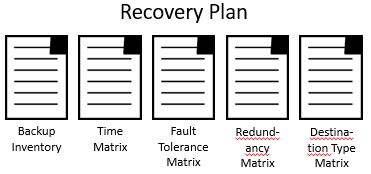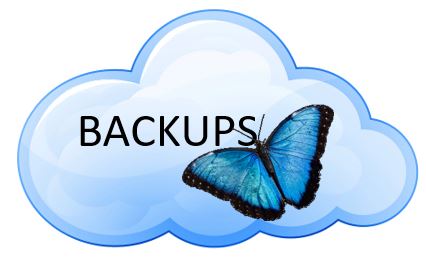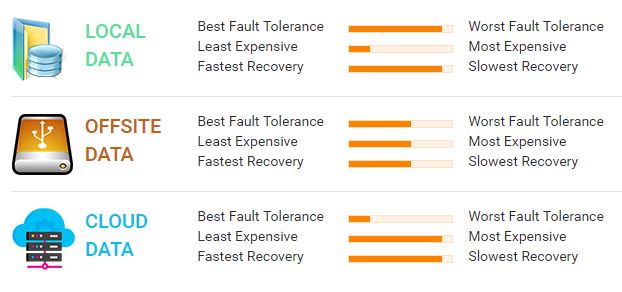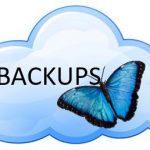
MOVING BACK-UPS TO THE CLOUD
MOVING BACK-UPS TO THE CLOUD
If you’re thinking about moving some of your I.T. services into the cloud, start with backups. Software configuration is fairly simple, reliability is excellent and the price is very good (depending on the backup service you choose). There is some solid work that must be done to clearly define a disaster recovery plan which will fuel your cloud backup strategy.
My first recommendation is to hire a professional company to help you with the details and point you in the right direction. You’ll save money, get a better solution, and free up your valuable time to focus on your business.
Buyer Beware
There’s lots of backup cloud services on the internet and they’re all advertising the great benefits of their service. My biggest beef with these companies are the following;
- They sell their backup space in chunks; 50GB, 500GB, etc. The problem with this model is the consumer has to pay for the entire chunk of data even if they don’t use it. This is a great model for the backup service, not a good model to hold down costs for the business owner.
- They don’t tell you how quickly you can get your data back when you need it. For some cloud companies, it could take a week or so because they throttle your data download to a trickle.
- They charge you a fee to recover your data.
- They charge you for I.T. assistance when it comes time to recover your data.
- They charge extra for server based backups.
Here’s what business owners need;
- Per GB pricing without having to purchase blocks of storage.
- Month by month contract so you’re not on the hook for a year or longer.
- No cost data recovery.
- No throttling of recovery data downloads with a wide pipe of at least 10mb/sec.
- No additional charge for specialized data such as databases, Exchange Email data, etc.
Getting Started
Define Data Destination Types and Backup Variables
There are three different types of destination points for back-up data. Local, Offsite, and Cloud. We make this distinction to help customers understand the pros and cons of each destination type and reduce their backup costs. The chart on the right helps visualize the pros and cons of each destination type.
- Local Data: Backups that remain on the same network as the data that is being backed up.
- Offsite Data: Backups that are taken home, stored offsite, or at another business location.
- Cloud Data: Backups that are moved to a 3rd party service in the “Cloud”.
Below are the definitions of each variable that is impacted given the destination type selected.
- Fault Tolerance: Will the data survive given a significant event such as; fire, earthquake, theft, hacking, tornado.
- Expense: The cost of backup.
- Recovery: How fast to recover your data after an event.
Build a Recovery Plan First
There are several steps for building a quality recovery plan

- Inventory the Data that needs to be backed up such as Databases, Images, Application data, Shared Documents, etc.
- Develop a Recovery Time Matrix: How fast do I need my data if I lose it to keep my business operational? See example on the right.
- Develop a Fault Tolerance Matrix: How important is my data? See example on the right.
- Determine a Redundancy Matrix between Backup Types. Example; I want my QuickBooks database backed up Locally and in the Cloud. This redundancy matrix helps protect your data while also providing speed of recovery.
- Build a Destination Type Matrix using the Recovery Time Matrix, the Fault Tolerance Matrix, and the Redundancy Matrix to bring all the information together.
- Develop a plan for testing backup recovery on a periodic basis.
Build a Backup Plan
Once the Recovery plan is complete move on to the Backup Plan. Here are the steps for a strong backup plan.
- Determine a software solution for each Destination Type (Local, Offsite, Cloud). We have found that the best solution involves specialized software for each destination type. Example; For Local Backups you could use a built in free software from Microsoft called “Windows Backup”. Each solution must have robust monitoring, reporting, and reliability while being best value as compared with other back-up solutions.
- Determine Retention period. Example; “I need to store a full copy of my database every day for 2 weeks. That way, if one backup is corrupted, a previous day’s backup could be used.
- Roll Out Plan
- Test Recovery Plan every 3 months
Summary
You’re all set. With the right knowledge, the right tools, and the right expertise, your company can get on the right path and be confident in a great cloud solution.
Baxter I.T. is available to discuss your goals and requirements for achieving the right solutions.
Author: William Baxter | President, Baxter I.T. Consulting Services.
Contact: wbaxter@baxterit.com | 972-886-4218.








